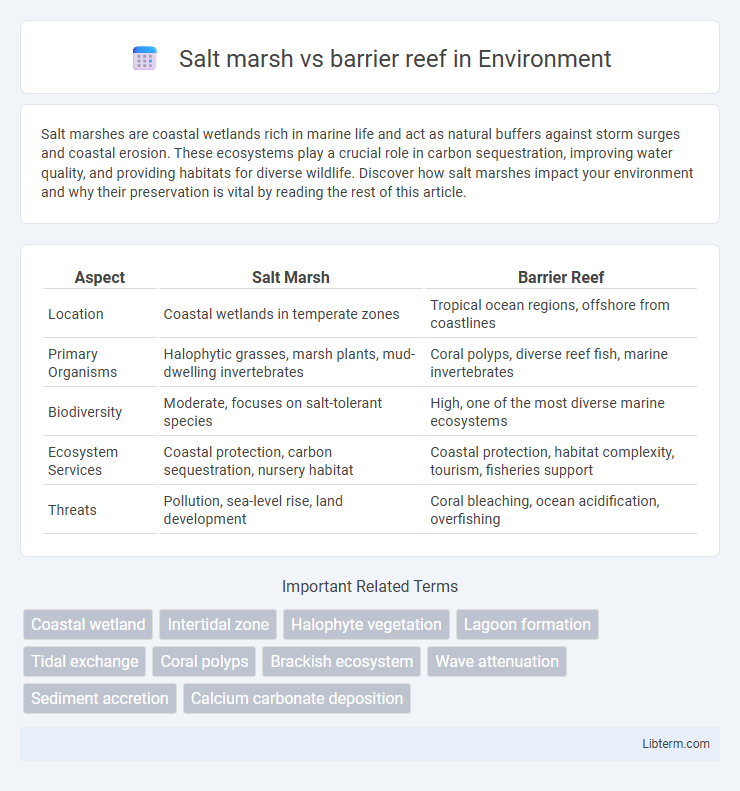Salt marshes are coastal wetlands rich in marine life and act as natural buffers against storm surges and coastal erosion. These ecosystems play a crucial role in carbon sequestration, improving water quality, and providing habitats for diverse wildlife. Discover how salt marshes impact your environment and why their preservation is vital by reading the rest of this article.
Table of Comparison
| Aspect | Salt Marsh | Barrier Reef |
|---|---|---|
| Location | Coastal wetlands in temperate zones | Tropical ocean regions, offshore from coastlines |
| Primary Organisms | Halophytic grasses, marsh plants, mud-dwelling invertebrates | Coral polyps, diverse reef fish, marine invertebrates |
| Biodiversity | Moderate, focuses on salt-tolerant species | High, one of the most diverse marine ecosystems |
| Ecosystem Services | Coastal protection, carbon sequestration, nursery habitat | Coastal protection, habitat complexity, tourism, fisheries support |
| Threats | Pollution, sea-level rise, land development | Coral bleaching, ocean acidification, overfishing |
Introduction to Salt Marshes and Barrier Reefs
Salt marshes are coastal wetlands rich in halophytic plants that thrive in intertidal zones, offering crucial habitats for diverse wildlife and acting as natural buffers against storm surges and erosion. Barrier reefs are extensive coral formations located offshore, characterized by vibrant marine biodiversity and serving as protective barriers that shield coastlines from wave action. Both ecosystems play vital roles in coastal protection and support rich biological communities, though their compositions and functions differ significantly.
Formation Processes: Salt Marsh vs. Barrier Reef
Salt marshes form through the gradual accumulation of sediment in coastal intertidal zones where salt-tolerant plants stabilize the soil and organic matter builds up over time. In contrast, barrier reefs develop from the calcium carbonate skeletons of coral polyps that grow in warm, shallow, and clear marine waters, often initiated around submerged volcanic islands or continental shelves. While salt marsh formation depends on sediment deposition and plant colonization, barrier reef formation is an active biological process driven by coral growth and bioerosion.
Geographic Distribution and Locations
Salt marshes primarily occur along temperate and high-latitude coastlines, such as the eastern coast of North America, the western coast of Europe, and parts of New Zealand, thriving in sheltered areas like estuaries and tidal flats. Barrier reefs are found mainly in tropical and subtropical regions, with notable examples including the Great Barrier Reef off the coast of Australia and the Belize Barrier Reef in the Caribbean, forming parallel to shorelines in warm, shallow ocean waters. These ecosystems demonstrate distinct geographic distribution patterns influenced by temperature, salinity, and tidal conditions.
Key Physical Characteristics
Salt marshes feature flat, low-lying coastal wetlands dominated by salt-tolerant grasses and organic-rich muddy soils that trap sediments and provide crucial habitats. Barrier reefs, such as the Great Barrier Reef, consist of large, rigid calcium carbonate structures formed by coral polyps that create complex underwater ecosystems with high biodiversity. Salt marshes experience tidal flooding and support nutrient cycling, while barrier reefs act as protective coastal barriers, reducing wave energy and preventing erosion.
Biodiversity and Species Diversity
Salt marshes support high biodiversity with numerous species of grasses, invertebrates, fish, birds, and microbes thriving in their nutrient-rich, brackish environment. Barrier reefs host exceptional species diversity, including thousands of coral species, fish, mollusks, and marine mammals, making them some of the most diverse marine ecosystems on Earth. The structural complexity of barrier reefs creates habitats that support intricate food webs, whereas salt marshes provide critical nursery areas and feeding grounds for many coastal species.
Ecological Roles and Functions
Salt marshes act as critical nurseries for a variety of marine species, filtering pollutants and stabilizing shorelines through dense vegetation that traps sediments. Barrier reefs provide essential habitats for over 25% of all marine life, supporting biodiversity by offering shelter and feeding grounds while protecting coastlines from wave erosion. Both ecosystems contribute significantly to carbon sequestration, but salt marshes primarily store carbon in soil, whereas barrier reefs rely on calcium carbonate structures.
Environmental Threats and Vulnerabilities
Salt marshes face environmental threats such as rising sea levels, increased pollution, and habitat fragmentation, making them vulnerable to erosion and loss of biodiversity. Barrier reefs are highly sensitive to ocean acidification, coral bleaching due to elevated sea temperatures, and physical damage from storms and human activities, leading to decreased reef resilience and marine species decline. Both ecosystems suffer from anthropogenic impacts that exacerbate climate change effects, threatening their ecological functions and services.
Human Impact and Conservation Efforts
Salt marshes face significant threats from urban development, pollution, and altered water flow, leading to habitat loss and decreased biodiversity. Barrier reefs suffer from overfishing, coral bleaching due to climate change, and ocean acidification, causing widespread reef degradation. Conservation efforts include restoring natural water regimes in salt marshes and establishing marine protected areas and coral restoration projects to support barrier reef resilience.
Climate Change Effects on Salt Marshes and Barrier Reefs
Salt marshes experience accelerated erosion and habitat loss due to rising sea levels and increased storm intensity linked to climate change, threatening their capacity to sequester carbon and support biodiversity. Barrier reefs face coral bleaching events, ocean acidification, and reduced calcification rates, leading to weakened reef structures and diminished marine habitats. Both ecosystems serve as critical coastal buffers but are increasingly vulnerable to climate-induced stressors that compromise their ecological functions and resilience.
Comparative Summary and Future Outlook
Salt marshes serve as critical coastal buffers, supporting diverse plant species and providing essential habitats for migratory birds, while barrier reefs are complex marine structures built by coral polyps that harbor rich biodiversity and protect shorelines from wave erosion. Both ecosystems face threats from climate change, such as sea level rise and ocean acidification, which jeopardize their ecological functions and resilience. Advances in conservation technologies and restoration projects aim to enhance the adaptive capacity of salt marshes and barrier reefs, promoting long-term sustainability and biodiversity preservation.
Salt marsh Infographic

 libterm.com
libterm.com